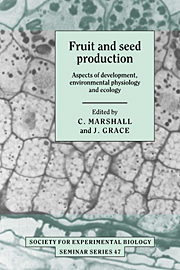Book contents
- Frontmatter
- Contents
- Contributors
- Preface
- Plant reproductive biology: an overview
- The environmental control of reproductive development
- Pollination and fertilization in higher plants
- Embryogenesis
- Environmental and internal regulation of fruiting, with particular reference to Cox's Orange Pippin apple
- Fruit growth and sink strength
- Control of grain growth and development
- The regulation of maternal investment in plants
- Ecological and physiological aspects of reproductive allocation
- Are the distributions of species determined by failure to set seed?
- Edible fruits in a cool climate: the evolution and ecology of endozoochory in the European flora
- Index
Edible fruits in a cool climate: the evolution and ecology of endozoochory in the European flora
Published online by Cambridge University Press: 04 August 2010
- Frontmatter
- Contents
- Contributors
- Preface
- Plant reproductive biology: an overview
- The environmental control of reproductive development
- Pollination and fertilization in higher plants
- Embryogenesis
- Environmental and internal regulation of fruiting, with particular reference to Cox's Orange Pippin apple
- Fruit growth and sink strength
- Control of grain growth and development
- The regulation of maternal investment in plants
- Ecological and physiological aspects of reproductive allocation
- Are the distributions of species determined by failure to set seed?
- Edible fruits in a cool climate: the evolution and ecology of endozoochory in the European flora
- Index
Summary
Introduction
Seed plants show a diversity of adaptations for seed dispersal. These adaptations may involve physical dispersal agents (transport by wind, water, gravity, etc.) or biotic dispersal agents (self-dispersal, or more commonly transport by animals), often combined in various ways, simultaneously, sequentially or as alternatives. The adaptations that are possible or appropriate for a particular species are constrained by its structure and ecology, by its physical and biotic environment, by its history, and by genotypic limits to the extent to which it can vary in response to selective pressures. Adaptations for dispersal interact with and may be conditional upon adaptations for pollination (e.g. the position, number, structure and phenology of flowers) and for seedling establishment (seed size and number, seed protection, seed shape, seed dormancy and seed placement) (Fenner, 1985; Primack, 1987). Seed size has a particularly close interaction with seed dispersal mechanisms (Harper, Lovell & Moore, 1970).
Adaptations for seed dispersal must thus be seen in the context of the complex web of competing and interacting adaptations, constraints and possibilities that affect and ultimately determine the biology of a species. Within a species, the factors affecting seed dispersal may not be uniform. Different populations or individuals of a species may, for example, grow in widely different physical and biotic environments. Even within a single population, the biotic and physical environment may change greatly through time. A population of a pioneering tree species like Rhamnus catharticus or Salix atrocinerea, for example, may pass from a colonizing stage in an open habitat to a late-successional stage in closed woodland.
- Type
- Chapter
- Information
- Fruit and Seed ProductionAspects of Development, Environmental Physiology and Ecology, pp. 217 - 250Publisher: Cambridge University PressPrint publication year: 1992
- 6
- Cited by

